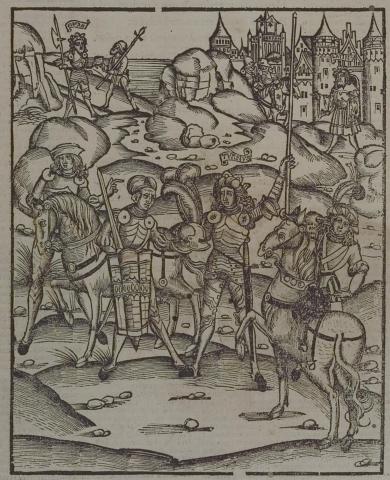Annotations
In the foreground, Turnus prepares for the duel. On either side of him, his two charioteers prepare his two horses for the fight, and the charioteer on the right combs the mane of his horse (81-86). Between the horses, a servant helps Turnus put on his armor. The servant holds a shield and sword, and hands a helmet to Turnus, who holds a spear in his hand and a sword at his waist (87-94). In the upper left, Aeneas, who has heard the challenge given by Turnus, gives a messenger his answer and terms of peace to King Latinus, who stands in the upper right outside Laurentum awaiting the response (107-12).
Woodcut illustration from the “Strasbourg Vergil,” edited by Sebastian Brant: Publii Virgilii Maronis Opera cum quinque vulgatis commentariis expolitissimisque figuris atque imaginibus nuper per Sebastianum Brant superadditis (Strasbourg: Johannis Grieninger, 1502), fol. 393r, executed by an anonymous engraver under the direction of Brant.


Sebastian Brant (1458-1521) was a humanist scholar of many competencies. Trained in classics and law at the University of Basel, Brant later lectured in jurisprudence there and practiced law in his native city of Strasbourg. While his satirical poem Das Narrenschiff won him considerable standing as a writer, his role in the transmission of Virgil to the Renaissance was at least as important. In 1502 he and Strasbourg printer Johannes Grüninger produced a major edition of Virgil’s works, along with Donatus’ Life and the commentaries of Servius, Landino, and Calderini, with more than two hundred woodcut illustrations. (Annabel Patterson)